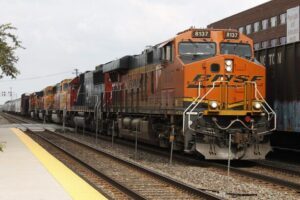At the annual DroneDeploy user conference in Denver, an inside look at one of DroneDeploy’s 3 pillars of development: automation. Nick Dryer, Field Operations Manager of the UAS Program at BNSF Railway provides an inside look at their automated drone operations for inventory management and more.
Railway logistics sites and intermodal facilities are complex pieces of the vast system of goods transportation: acres and acres of narrow parking spaces to store containers delivered by trucks. These containers and contents are identified by number, and must be retrieved and connected with the appropriate trains – to the right place, at the right time. The sites are dynamic and, like any structure, require constant management and maintenance. Automating pieces of the process offers major benefits for supply chain systems: and automated drone operations can provide one piece of the solution. Nick Dryer offered insights on how their program has evolved – and where it’s headed.
The Foundation of Automation: Good Data
In order to automate anything, Dryer points out, you have to start with good data. You have to know exactly how many parking spots there are on each site, and you have to know if everything is where it is supposed to be on the site: which container each space contains.
Drones offer a perfect solution for accurate inventory, Dryer explained. You can’t use sensors mounted to poles because of the wind, which over time causes the accuracy of the data to be off by up to 5 spaces. Automated drone operations – utilizing drone-in-a-box solutions that can launch and fly automatically on a schedule – provide the best operational efficiencies.
BNSF started their program by mapping every single intermodal facility, manually drawing more than 50,000 parking spaces and giving them attributes. (Note: the new AI-powered features DroneDeploy is developing – demonstrated this morning – could help eliminate this step.) With that basis for their AI-powered inventory system, they can now execute automated data collection, using drones in docks situated throughout the facility. The drones fly at low altitude over the containers every 30-90 minutes, gathering the container ID and the parking space number for a constantly updated inventory and real-time visibility from any vantage point. By flying over the containers, they do not fly over people or moving vehicles, limiting operational risk.
The Long Term Vision for Automated Drone Operations
BNSF is on the cutting edge of automated drone operations for large enterprises. Currently, they are the only railroad with approval to operate the systems beyond visual line of sight of the pilot (BVLOS). The company is working towards permissions for operating multiple drones by 1 pilot: initially for 1:5 staffing, and scaling in the future. It’s a project that has required long term vision and investment to realize, and it continues to evolve.
These flights also gather thermal imagery. The thermal images are not used for the inventory management system, but are used by security personnel responsible for the site at night: allowing them to see any unauthorized people in the area. The company is looking at other use cases: monitoring the departure of trains, or developing a pavement model without having to empty the site by surveying individual parking slots while they are empty.
“The use cases are endless,” said Dryer. “Our facilities are ever changing and growing…As we let people know what’s available, they come up with new ideas.” Next year, the program will scale to 6 more locations, having proven it’s value.
“We really don’t like calculating ROIs,” said Dryer. “At the end of the day, safety is our ROI.”
Dryer envisions that the program will continue to expand as the technology evolves. “The UAS Applications for drone in a box are very much still in the crawling stage,” he said. “But the future is very, very bright.”
Read more:
Miriam McNabb is the Editor-in-Chief of DRONELIFE and CEO of JobForDrones, a professional drone services marketplace, and a fascinated observer of the emerging drone industry and the regulatory environment for drones. Miriam has penned over 3,000 articles focused on the commercial drone space and is an international speaker and recognized figure in the industry. Miriam has a degree from the University of Chicago and over 20 years of experience in high tech sales and marketing for new technologies.
For drone industry consulting or writing, Email Miriam.
TWITTER:@spaldingbarker
Subscribe to DroneLife here.


